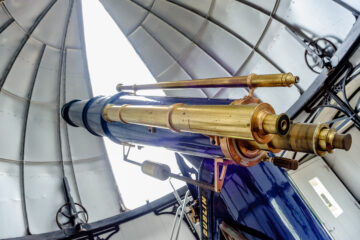SECOND-WETTEST FEBRUARY ON RECORD AT ARMAGH, MILDER AND SUNNIER THAN AVERAGE. WINTER 2019/2020 WETTER, WARMER AND SUNNIER THAN AVERAGE
Armagh Observatory reports that February 2020 was very wet, the wettest February at Armagh for 30 years and the second-wettest February on record at Armagh. It was also milder and sunnier than average. The meteorological winter (December 2019, January 2020 and February 2020) was warmer, wetter and sunnier than average.
Total February precipitation was 147.45 mm (5.81 inches) including 1 trace value, that is, 147.40 mm if trace values are ignored. This is approximately 2.7 times both the long-term (1796–2010) and the most recent (1981–2010) February averages at Armagh, making February 2020 the second-wettest February on record at Armagh, that is, since daily rainfall measurements began at the Observatory in 1838. The wettest day was the 23rd with 21.8 mm (0.86 inches) of precipitation, and the second-wettest was the 8th with 20.4 mm (0.80 inches) of rain, this high rainfall associated with passage of Storm Ciara.
The three wettest Februarys at Armagh are now those of February 1990, 2020 and 1923, with respective monthly precipitations totalling 153.7 mm, 147.4 mm and 137.8 mm respectively. It should be noted, however, that when compared to other months of the year February at Armagh (along with January, March, April and May) is not normally associated with a very high monthly rainfall. Moreover, considering the most recent (1981–2010) 30year average precipitation for each month at Armagh, the mean monthly rainfall for February (54.1 mm) is the lowest of all the twelve months, and this year’s February total (147.4 mm) is not even in the top thirty of the wettest calendar months at Armagh since 1838.
Snow was recorded as falling on five days (and sleet on a sixth), with hail or ice pellets on four days. Despite a succession of powerful Atlantic storms (Ciara, Dennis and Jorge) affecting the UK and Ireland this February, Armagh escaped relatively lightly. There were only two days when the strength of the wind, as judged by the meteorological observers, was estimated as gusting to gale force, namely the 8th and 15th, associated respectively with Storm Ciara and Storm Dennis. The 8th was noteworthy for seagulls seen flying in the wind over the Observatory grounds that afternoon. There were several days of high rainfall during the month, but none exceptional. For example, the highest daily rainfall at Armagh this February was 21.8 mm on the 23rd, which ranks 19th in a list of the wettest February days at Armagh since 1838.
The mean monthly temperature was 5.54 degrees Celsius (42.0 F), which means that February 2020 was mild, 0.93 C warmer than the long-term (1796–2010) average February temperature at Armagh and 0.62 C warmer than the most recent (1981–2010) 30-year average.
The warmest day (highest maximum air temperature) was 12.7 C on the 28th, followed by 11.3 C on both the 9th and 21st. The coldest day (lowest maximum air temperature) was 3.0 C on the 11th, a result which was preceded by the second-coldest day of the month, namely 4.3 C on the 10th. The coolest night (lowest minimum air temperature) was just 0.6 C on the 27th, followed by 0.3 C on the 24th. The warmest night (highest minimum air temperature) was 7.3 C on the 1st, followed by 5.2 C on the 15th.
There were 20 nights with ground frost (minimum grass temperature less than or equal to zero), the lowest two of which occurred on the 11th and 17th, with minimum grass temperatures of -6.9 C and -4.8 C respectively. There was just one night (the 27th) with a minimum air temperature less than or equal to zero.
With 83.7 hours of strong sunshine, February 2020 was sunnier than average, as indeed were each of the previous two Februarys at Armagh, with approximately 19% more strong sunshine than the long-term (1881–2010) February average at Armagh and 21% more than the most recent (1981–2010) 30-year average. The sunniest day was the 27th with 7.0 hours of strong sunshine, preceded by the second-sunniest day on the 26th with 6.5 hours.
Taking the meteorological winter 2019/2020 as a whole, that is, the months December 2019, January 2020 and February 2020, this year’s winter at Armagh was warmer, wetter and sunnier than average. The mean winter temperature was 5.87 C (42.6 F), which is approximately 1.5 C warmer than the long-term (1796/1797 – 2010/2011) average winter temperature at Armagh, and 1.0 C warmer than the most recent (1981/1982 – 2010/2011) 30-year average.
There was also more rain this winter than average. The slightly drier than average December 2019 and the much drier than average January 2020 at Armagh were more than compensated by the much wetter than average February 2020. Including 18 trace values, total precipitation for winter 2019/2020 at Armagh was 261.3 mm (approximately 10.3 inches). This is more than 25% greater than the mean winter precipitation at Armagh, leading to this winter 2019/2020 being the wettest at Armagh for two years.
The total number of hours of strong sunshine recorded during winter 2019/2020 was 177.5, which is approximately 10% more than the average number of hours of strong sunshine at Armagh. This winter was the sunniest at Armagh for two years.
These data refer to observations at Armagh Observatory, which has been recording the weather at Armagh since 1795.



0 Comments